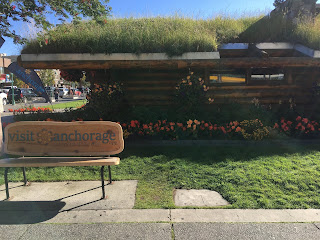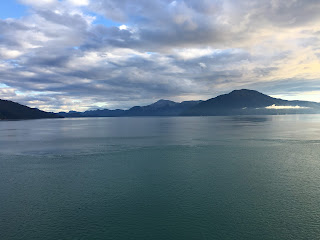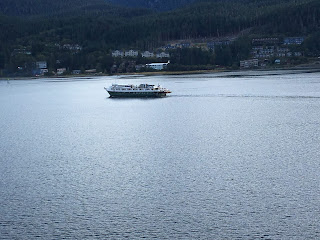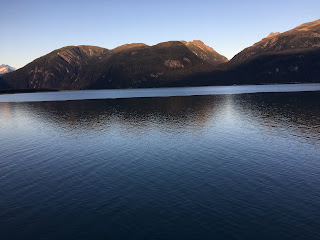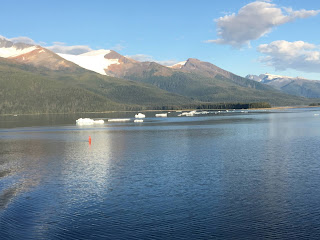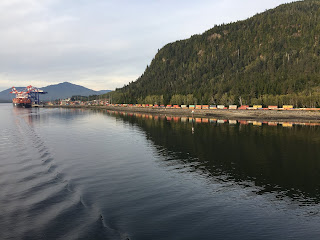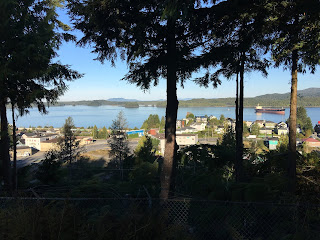North—-To Alaska & Canada
September 2018
We booked a Seabourn cruise through Catherine with American Express Travel. Deciding to go in early, we had a room at the Captain Cook Hotel in Anchorage. All air and hotel arrangements, including transfers to and from the ship, were made with the cruise line.
We flewAlaska Airlines 651 to Seattle where we connected to Alaska Airlines 95 to Anchorage. We landed in Anchorage at 8:04pm; Anchorage is 3 hours behind Dallas. Upon arrival Baggage Claim, we connected with Crissy, a Seabournrepresentative, who informed us that a coach to the hotel just left. They had vouchered a taxi for us so that we wouldn’t have to wait. Upon arrival at the Captain Cook Hotel, we received a welcome packet, keys to room 517, and some other information from another Seabourn representative. The comfortable room was a junior suite; breakfast was included with our room.
We spent several days enjoying Anchorage. We had no plans. As this was not our first visit to Alaska’s largest city, we just enjoyed wandering. We window-shopped a lot. We did go into a couple of souvenir shops, but felt inundated with t-shirts and caps. One day we walked over to the Anchorage Market and Festival held in a large parking lot on 3rd Street. There was live music on a makeshift stage. Tents were arranged in rows and we walked those where vendors had crafts, merchandise, and/or homemade items. One unique shop was Oomingmak Musk Ox Producers Cooperative. The person running the shop explained how qiviuit,the fiber, is collected from Musk Oxen, spun, and knitted into garments by native women in remote villages. We were the only customers and received an excellent briefing.
Another day we caught the Anchorage Trolley Tour.
Alice was our driver/guide for the one-hour loop, which included a history of Anchorage as well as visits to Earthquake Park and to Lake Hood, where the floatplanes take off and land.
Alice entertained us by interspersing her narrative with clever songs.
Seabourn Sojourn Cruise
Anchorage to Seward - Our schedule called for us to have luggage ready inside the room at 8:00 and be ready to board the coach at 8:45. We were told the scenic drive along Turnagain Arm would take about 3 hours. The bus left just a few minutes late, but the drive to Seward was pleasant. We enjoyed watching the scenery. In some areas trees had begun to change and fall colors of brilliant yellow, gold and red mingled with the evergreens. We saw a couple of pairs of “Trumpeter Swans” and two “Eagles perched atop a dead tree in another spot.
It was just about noon when we arrived in Seward. Check-in for the Seabourn Sojourn went smoothly. As we boarded, we were directed to Deck 8 where lunch was being served. After eating, we waited on Deck 9 until the “Suites Are Ready” announcement at 2:30. Our luggage was atop the bed, so we began unpacking. Milena, our Stewardess from Rio, arrived with canapés and champagne. There was a muster drill at 5:15. Our balcony view included white glaciers clinging to gray crevices on the sides of mountains with green bases---all scrunched between a blue sky streaked with white clouds and deeper blue water.
It had been announced that the Aurora Borealis might be visible between 3:00am & 4:00am. We set the alarm before going to bed, got up, saw nothing from our balcony but bright stars, including The Big Dipper, and returned to bed.
Holgate & Aialik Glaciers – When we got up, black and yellow zodiacs and orange kayaks plied the water at the foot of the glacier outside our suite. The ship was stationary at the bases of the Holgate andtheAialik Glaciers for these activities. A bright sun in mostly clear and blue skies made water, ice and snow sparkle and glisten. In the Observation Bar on deck 10, we sat and watched the scenery: dark mountains splattered with white glaciers; slate-colored water speckled with floating ice in irregular shapes.
During his noon briefing, the Captain said there was no visible Aurora Borealis last night, but remarked on how clear the skies were and the brightness of Ursa Major. We went to our balcony and sat in the sun for about half an hour and watched chunks of glacial ice float past. The bright sun became too hot, so we went back inside. We did have a nice sunset.
Gulf of Alaska – Today we cruised across the Gulf of Alaska. We had hoped to see some sea life, but did not. Blue skies were streaked with white clouds, but today’s wind was stronger than yesterday’s, and it felt colder on the shady side of the ship.
Inian Islands & Icy Strait Point – Within the Inian Islands,we stopped for kayaking, exploring by zodiac, and other activities. We watched the scenery through the windows of our suite before going to the Observation Bar where we sat and watched the scenery until almost noon.
After lunch, we returned to the room and watched the docking process at Icy Strait Point, the only privately owned dock in Alaska. The Tlingits occupy Hoonah, a fishing village on Chichagof Island, and they created Icy Strait and constructed the dock to facilitate and encourage tourism.
We got ready for our tour, Whale Watch & Marine Mammal Safari, scheduled to depart at 2:30. After boarding the catamaran, we sailed from Prince Frederick to search for anOrca. We found an Orca Bull and watched him for quite a while; his fin was probably 6 feet tall. It was our first time to ever see one in the wild.
The smooth water made standing on the bow viewing deck easy. After watching the orca for a while, we headed back past Hoonah and the dock and out into Icy Strait itself where we searched for Humpback Whales. We found a few and saw several blows and fluke flips before heading back to the dock. It wasn’t the most impressive Humpback display we’d ever seen, but we still enjoyed it. The water in the strait was much more choppy, so we stayed inside as we were too unsteady on the outside deck.
Juneau - We tied up alongside in Juneau, Alaska's capital, about 8:00. The Mount Roberts Tramway was just across the dock from the gangway, so we used our prepaid tickets and rode to the top. Clear blue skies and a brilliant sun made the water sparkle and the views as good as possible.
After exiting the tram, we went outside to see a captive bald eagle named Lady Baltimore. Known as Lady B, she is estimated to be at least 17 years old, weighs 10 1/2 pounds and has a wingspan of 6 1/2 feet. She was found injured on Juneau’s Douglas Island. Having been shot in her beak and her right wing, she was left blind in one eye and unable to achieve full flight. Since she couldn’t be returned to the wild, she is kept by the Juneau Raptor Center where she feasts on salmon heads. Today was the last day for her to be displayed in this location this season.
After seeing the eagle, we walked back into the building and wandered through the gift shop, buying nothing.
After riding the tram back down,
we walked along the main street and went into several stores. Many jewelry stores offer “free gifts” and other enticements; we’re not easily lured.
We crossed the street, walked past the Regent Seven Seas Mariner, and returned to the ship to sit on the balcony.
We enjoyed the sail as we left Juneau.
Haines - Haines is a very small town—-population 2500—which hugs the bay area. Except for the glacier topped mountain backdrop, it could be anywhere in New England. That could be because most of the houses are remnants of Fort William H. Seward, Alaska’s first military base, constructed in 1903. We disembarked and walked the long, sturdy pier to shore. Once ashore, we waited for the free shuttle bus, which made a 15-minute loop through town. We rode the entire loop, but decided against returning to any of the five stops to look around. We walked into a couple of gift shops/souvenir stores across from the pier before walking back to the ship.
It was too sunny and warm to sit on the balcony. We sailed from Haines at 6:00 and down the Lynn Canal.
The Captain announced that we should arrive in Tracy Arm about 7:00 a.m. tomorrow. Seeing the glaciers atop the mountains as we sailed out was incredible.
Tracy Arm - When we awoke, we were sailing into Tracy Arm. Varied sizes of white glacial ice chunks with deep blue markings floated in the teal-colored water. Almost sheer gray walls were on each side of the ship; in some places, green bushes broke up the rocky expanse. In others, trees topped them. We reached our destination to “anchor” for various zodiac, kayak, and catamaran tours. Spectacular views of glacial topped mountains appeared no matter which direction we looked. We went to the Observation Bar, where we spent the remainder of the morning almost mesmerized by the view before us. Brilliant sunlight caused the water to shimmer and sparkle and intensified the glacial blue in some of the ice pieces. Watching the catamaran and the zodiacs gave perspective to the view and showed the size of some of the floating bergs. The beautiful scenery required lots of photos today.
Sitka - Our tour, Sea Otter & Wildlife Quest,had a 10:30 meeting time on the pier. We watched from our balcony, and when they allowed people to begin boarding the catamaran, we disembarked.
The St, Eugene had a naturalist, a captain, and 3 crew aboard. The boat wasn’t full and there was plenty of room to move around and take photos. It was another sunny day with blue skies and warm temperatures. We sat inside on the lower deck and watched through the windows.
After leaving Sitka, we sailed out east and located some Sea Otters. Groups of them are called rafts; whether this is because they hold onto each other or use the Bull Kelp to attach to each other wasn’t explained. We saw several different rafts as well as a few single Sea Otters and a Harbor Seal.
Small white floats indicated the presence of crab or shrimp pots deployed by local fishermen.We continued sailing and saw a couple of Bald Eagles.
On our quest for other mammals, we saw numerous birds and sailed among islands with rocky bases and forested interiors. The landscape was pristine: deep blue water, gray rocks; green trees; blue skies; little sign of human habitation. We were told the topsoil is only 6 to 10 feet deep, and the topography proved that to be true.
The Captain took us to an area where several Humpback Whales were feeding. We saw numerous “blows,” arching backs, and “tail flips.” We also saw at least one “flipper wave.”
The three-hour-tour ended in town. We elected not to wander around downtown and rode the shuttle bus back to the ship. At 5:00, we sailed and we just relaxed for a while. Less than an hour after sailing, a boat came speeding out of Sitka and a helicopter circled before zeroing in on the boat. The helicopter hovered and then lowered a basket. We didn’t see the helicopter take off, so had no idea where it went, but we think it was a practice run.
Wrangell - Today’s tour, Wrangell Highlights,met at the end of the pier at 8:45.
Carrie was our driver/guide and our transportation was a yellow school bus.
Our first stop was Wrangell Museum, which contained artifacts from the town’s past.
Items were well-displayed with easy-to-read descriptions; some displays, such as the one of different types of furs, were interactive. One interesting exhibit was about Garnet Ledge, an area where garnets can be pried from the rock as individual stones. The mining area was originally a company owned and operated by women; the first such in the US. Its last owner gave the mine to the Boy Scouts of Americawith the provision that the children of Wrangell be the only ones allowed to mine the stones. We were told the children still do this and often sell to tourists. [Because it was a school day, there were none hawking their wares today. However, a portion of the proceeds from the stones sold in the museum shop goes to children.] After leaving there, we drove to the dock area where the fishing industry’s impact was explained; it’s the main source of income for the town, especially since the installation of two huge haul-out cranes for boat repair. Shrimp, crab, salmon, salmon eggs, and salmon oil fill containers headed for Asia and the US.
After leaving that area, we picked up John, a Native man, who provided interesting and entertaining commentary on the cultural influence of that group in Wrangell. He spoke of the reconstruction of Chief Shakes’ Tribal Houseand the historic celebration held to commemorate that event. He also provided interpretation at Kiks Adi Totem Park.
We left John at the park and drove through town hearing about the buildings we passed and seeing the exteriors of some of the oldest churches. The red neon cross atop the Presbyterian Church is used as a navigation beacon; the only other one in the world so designated is in Norway. Our last stop was Petroglyph Beach, site of ancient petroglyphs on rocks found on the beach. A wooden platform containing replicas of some of the petroglyphs has been constructed above the beach; some made rubbings of the replica petroglyphs.
We drove through the area once occupied by Fort Wrangell on our way back into town. It was another bright, sunny day with temperatures in the low-70s.
Ketchikan - Floatplanes were taking off beside our docked ship. Skies were totally overcast early but had cleared by 9:30. Without a tour booked today and having been here twice previously, we decided to just “have a wander”—-as the Aussies say. There were four ships in port today: HAL New Amsterdam; HAL Eurodam; Ruby Princess; Seabourn Soujourn. That meant lots of tourists in a small town. We walked into downtown Ketchikan and began to wander into and out of the shops. Most sold typical souvenirs of t-shirts, caps, mugs, magnets, etc. Christmas Alaska, was a huge store filled with Christmas décor of all kinds. At Ketchikan Candy & Souvenir Store where we bought ice cream; it was one scoop for $3.49 or two scoops for $4.49; we had 2 scoops each. After gorging on ice cream, we wandered several more blocks and into and out of more stores. We resisted the “free gift” offers and the hard sell techniques, although it wasn’t as bad as Juneau. We headed back to the ship, got drinks from the refrigerator in the suite, and sat on the balcony. About 1:30, the sun’s angle changed and we went inside.
The Captain announced we would be sailing just after 8:00 and would follow The Niew Amsterdam; our route would take us by the airport.
Our course would be to sail South and then sail a test pattern for the ship’s noise signature to be measured. This is a requirement for the permit to sail into Glacier Bay. Sometime around midnight, testing completed, we would return to Ketchikan and then sail to tomorrow’s destination.
Rudyerd Bay - Looking outside in Rudyerd Bay, we saw “the forest primeval” with perhaps “murmuring cedars, fir, and spruce” instead of “pines and hemlocks.” Almost sheer rock walls with evergreen trees clinging to them surrounded the ship. The water appeared dark, more a reflection of the surrounding vegetation and walls than the clear blue sky above. It was a gloriously warm day. We went to the Observation Bar and stayed until 11:45 and then ate lunch on the pool deck. We sat on the balcony and enjoyed the sunshine for a while; when the ship turned and the balcony was in the shade, we came inside for a while but went back outside later.
Prince Rupert, BC, Canada – We awoke to another warm, sunny day. Today’s tour, Prince Rupert City Highlights,was the epitome of “They can’t show you what they don’t have.” Founded to be the Pacific terminus of the Trans-Canada Grand Trunk Railway, it lost its major early advocate when Charles Hayes went down with the Titanic. One can still travel from Prince Rupert by rail across Canada to the Atlantic Coast or drive the 4000 miles on Highway 16. We left the pier at 9:00 and drove through the small town seeing the port area known as Cow Bay, and other buildings, mostly houses. All are wooden and many in the Craftsman Style. Even a couple of large churches are constructed of wood. When asked, the guide said there was one brick house built with “leftover” brick by the man who constructed the brick courthouse.
We saw remnants of “China Town,” and the guide passed around numerous copies of historic photos. Locals call the town “Rainy Rupert” because it’s rare to have three consecutive days without rainfall; they also note that it’s named for Prince Rupert of the Rhine, [first governor of the Hudson’s Bay Company] a person who never even visited Canada. Another odd fact is that someone from Boston, Massachusetts designed both this town and its neighbor, Prince George. The closing of the pulp mill in 2001 devastated the population by about half. A fire completely destroyed the port area in 1972, but they’re hoping renewed port activity will revitalize the town, because they have the third deepest ice-free harbor in the world.
After winding our way to the top of a hill for a somewhat obscured-by-foliage view,
we drove back into town and to the Kwinitsa Railroad Station Museum, a restored railroad station/station master’s home.
Our last stop was the Museum of North British Colombia, a new building in the style of a tribal house. It had a large First Nations collection, mainly Haida, as well as a few other items.
Klemtu - Today the ship was in Klemtu, a First Nations village and home to the KitasooandXai’xais people. No other cruise line calls at this village of 460 people. Last night we received details for a cultural experience ashore. The program included a cultural performance in the Big House followed by a salmon BBQ. We were assigned a 10am tender ticket. Our luck with the good weather ran out. The day dawned overcast and cool. About 9:30, the Captain announced that today’s plans ashore had been canceled because of weather; the forecast included drizzle and/or rain and the BBQ venue has no covering. After apologizing, he said, “We will just have to bite the biscuit.”
He stated that the ship would depart around 11:00 at the conclusion of the “Ventures” program. It was actually closer to 11:30 by the time the zodiacs were back aboard, but we had sailed to be closer to their exit from their exploration area. At noon, the Captain announced our new route through various channels to provide a more scenic journey; most of the scenery was forest and the skies remained overcast with occasional drizzle. Scenic cruising isn’t at its best when skies are overcast and there’s drizzle. Shortly after 3:00, we went to the Observation Bar; it was much fuller than usual. Everyone was watching our scenic cruising. We reached the end of the passage and were at Ocean Falls, a former newsprint mill town now largely abandoned. It does have a hydroelectric plant. Access is by boat or float plane. We were told that the majority of the structures, including homes and a dilapidated hotel, still contain furniture because the residents abandoned the town by boat and only took what they could carry in luggage. About 50 people, mostly employees of the power company, live there.
We made photos before the ship turned around. When we did, the mist and fog thickened and we sailed in an eerie, ethereal landscape.
Limited visibility combined with drizzle to make being outside unpleasant.
Alert Bay - Alert Bay is a village of 1200 to 1500 people on Cormorant Island in British Columbia, Canada. The fog horn blew several times during the night’s sailing. When we arrived at Alert Bay before 8:00, thick fog hugged the treetops. Small wooden structures lined the short shoreline.
We rode a ship’s tender ashore around 10:15. A lady checked our names off a list as we reached the pier; we were told we needed a photo ID, but that was wrong. There wasn’t much to see in the town; very few businesses were open; only 4 or 5 vehicles passed us on the street. We talked to a lady who gave us ideas on which directions to walk. We found the cemetery fascinating with its totem poles.
After wandering uphill and looking at several buildings in need of maintenance, we turned around and walked past the pier to the Visitor Centre where we learned the Cultural Centre opened at 2pm.
It was warm and humid ashore. We returned to the pier, were checked back off the island by the same lady who checked us on, and boarded a tender back to the ship. After sitting on the balcony for a little while, the ship’s angle changed and it became chilly. The town looked more picturesque in the sunlight—-without the fog—-and we made photos in the afternoon.
We saw National Geographic’s Seabird, a much smaller cruise ship, in port and also saw a couple of ferries, so it’s not as isolated as it appears.
Vancouver - We received instructions that we would be disembarking at 9:45 but must vacate our suite by 8:00. We were instructed to meet in The Clubon Deck 5 at 9:15. I made a few photos of the harbor area and of seaplanes as we were tying up to Canada Place, the cruise ship terminal.
As per our instructions, we went to our assigned area on Deck 5 about 8:20 to wait for disembarkation. Sometime around 9:20, they finally decided we could leave; we think we were the last people off the ship. We, four others, and our luggage were loaded into a van and driven to the Fairmont Pacific Rim Hotel. It’s almost just across the street from the Canada Place, but one-way streets made the drive longer. We checked in before 10:00, but no rooms were available as, “The hotel is fully committed.” After picking up our departure instructions for Vancouver on Saturday from a Seabourn Hospitality Table on the second floor, we sat in the lobby and waited until receiving a text just before noon that the room was available. We picked up our key and made our way to room 826.
Having been to Vancouver previously, we had no specific plans. We wandered the downtown area some. Once we walked across the street to the waterside where we watched floatplanes take off and land while dodging watercraft. Helicopters hovered overhead or circled the area.
We made several photos including some of the Olympic Cauldron from the 2010 Olympic Games.
Two cruise ships, Grand Princess and Oceana Regatta were in port.
Flying - The car was waiting when we got to the lobby, and we left the hotel at 9:45; the ride to the airport took about 30 minutes. Upon arrival, we hired a porter and checked in for Delta 2898 scheduled to depart Vancouver at 12:45. We went to Securitywhere everything was checked and they even emptied our backpack. They didn’t find anything. Our next stop was US Customs & Immigration. As we left that area, we were offered a ride to the gate. Luckily, we accepted, as it was a long way. The flight boarded and left on time; it was a smooth ride. Upon arrival in Salt Lake City, we located the next flight on the board and walked to that gate. Delta 2126 departed on time and we landed at DFW a little earlier than scheduled.
